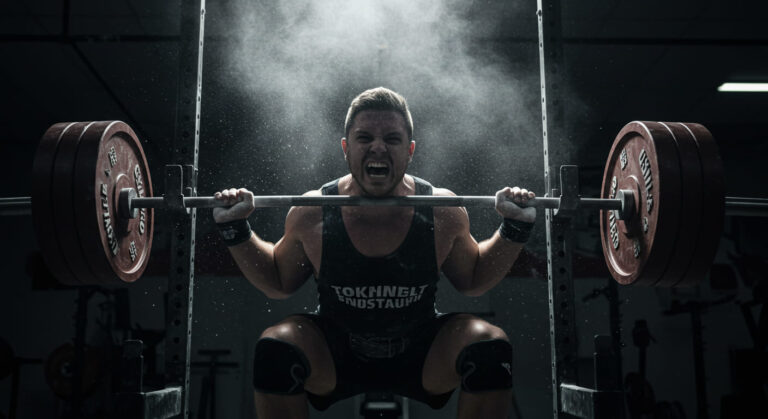If your bench press has been stuck at the same weight for months, you’re not alone. It’s the most common frustration in the gym. The secret to breaking through that barrier isn’t just “lifting more”—it’s a systematic, intelligent approach. This guide provides a complete roadmap to progressive overload for bench press, the single most critical principle for building a bigger, stronger chest. We’ll break down exactly how to apply it, from simple weight increases to advanced techniques, ensuring you never get stuck again.
Quick Answer: What is Progressive Overload for Bench Press?
Progressive overload for the bench press is the principle of continually increasing the demands placed on your chest, shoulders, and triceps over time to stimulate growth in muscle size (hypertrophy) and strength. This isn’t just about adding more weight. It can also be achieved by doing more repetitions, more sets, increasing training frequency, or improving your technique to create greater muscle tension and force adaptation. Without it, your body has no reason to get stronger.
What Exactly Is Progressive Overload for the Bench Press?
At its core, progressive overload for bench press is a simple yet powerful concept rooted in biology. Our bodies are incredibly efficient and will only adapt when they are forced to. When you perform a bench press, you create stress and microscopic tears in your muscle fibers. In response, your body repairs these fibers, making them slightly bigger and stronger to better handle that same stress in the future. This is the essence of bench press strength adaptation.
However, if you lift the same weight for the same number of reps and sets every week, your body quickly adapts to that specific stimulus. It sees no new threat and has no reason to continue growing. Progress stalls.
Progressive overload is the act of strategically introducing a new stimulus that is slightly more challenging than the last. This forces your body into a continuous cycle of adaptation and growth. Think of it as a conversation with your muscles:
- You: “Lift this weight.”
- Muscles: “Okay, that was tough, but we did it. We’ll prepare for that next time.”
- You (Next Session): “Great. Now lift this slightly heavier weight, or do one more rep.”
- Muscles: “Whoa, okay. We weren’t fully prepared for that. We need to get even stronger.”
This process is what drives both strength and size. The key is bench press mechanical tension growth; by increasing the challenge, you increase the tension on the muscle fibers, which is a primary signal for bench press muscle hypertrophy protocol. A well-designed progressive bench press programming plan ensures this increase in demand is consistent, manageable, and sustained over the long term. It’s not about making huge jumps every workout but about applying a small, consistent push that accumulates into massive gains over time.
The Undeniable Benefits of Applying Progressive Overload to Your Bench
Simply showing up to the gym and going through the motions won’t cut it if you have serious goals. Implementing a structured approach to progressive overload for bench press is what separates casual lifters from those who achieve consistent, impressive results. The benefits go far beyond just a bigger number on the bar.
1. Continuous Strength Gains
This is the most obvious benefit. By constantly challenging your muscles, you ensure a steady increase in your one-rep max (1RM) and your working sets. This principle is the foundation of getting stronger. Each successful overload—whether it’s adding 2.5 lbs or doing one extra rep—triggers a bench press neurological adaptation. Your central nervous system becomes more efficient at recruiting muscle fibers, allowing you to produce more force and power. This is the core of true strength building.
2. Significant Muscle Growth (Hypertrophy)
While strength and size are related, they are not the same. Progressive overload is the primary driver of both. To build muscle, you need to create sufficient training volume bench press and mechanical tension. By systematically increasing your reps, sets, or weight, you ensure you’re providing the necessary stimulus for bench press hypertrophy overload. Over time, this consistent challenge forces muscle fibers to grow thicker and more resilient, leading to a visibly larger and more defined chest, shoulders, and triceps. There’s a clear distinction in program design for bench press strength vs hypertrophy overload, but both rely on the same core principle of “doing more.”
3. Shattering Training Plateaus
Every lifter has experienced it: the dreaded plateau where your progress grinds to a halt. This happens when your body has fully adapted to your current routine. Progressive overload is the definitive tool for bench press plateau breakthrough. If you can no longer add weight, you can switch the stimulus. You can:
- Increase your reps.
- Add an extra set.
- Slow down your tempo.
- Decrease rest periods.
By changing the variable, you present a new challenge that your body hasn’t adapted to, forcing it to respond and breaking you out of the rut. A smart plan for overcoming a plateau involves using different overload methods.
4. Enhanced Power Development
Power is the ability to move weight quickly (Force x Velocity). Techniques like bench press dynamic effort, where you lift a submaximal weight as explosively as possible, are a form of progressive overload. By focusing on bar speed, you are challenging your neuromuscular system in a different way, improving your rate of force development. This not only helps you become more athletic but can also help blast through sticking points in your heavier lifts.
How to Systematically Apply Progressive Overload to Your Bench Press

Knowing you should use progressive overload is one thing; knowing how to apply it is another. The goal is to make progress measurable and repeatable. Here are the most fundamental and effective methods for a stronger bench.
The Classic Method: Increasing Bench Press Weight Gradually
This is the most straightforward form of overload. The goal is simple: add more weight to the bar.
- How it works: Once you can successfully complete your target rep and set scheme with a given weight and good form (e.g., 3 sets of 5 reps at 200 lbs), you increase the weight in the next session.
- Implementation: The key is making small, manageable jumps. Don’t go from 200 lbs to 225 lbs. A bench press load increase should be modest. This is where bench press microloading comes in. Using 1.25 lb or 2.5 lb plates allows for tiny micro-progression increments that add up significantly over time. This method is the backbone of many linear bench press progression programs, where you aim to add a small amount of weight each week.
Quick Tip: Invest in a pair of micro-plates (1.25 lbs each). Making a 2.5 lb jump is far more sustainable week after week than a 5 lb jump, especially for intermediate and advanced lifters.
Keeping track of all these variables week after week can be challenging. To take the guesswork out of your training and ensure you’re always making progress, use this free Progressive Overload Planner to design and visualize your weekly bench press plan.
Bench Press Volume Progression: More Reps and Sets
If you can’t increase the weight, increase the total work done. This is the essence of bench press volume progression and is an incredibly effective tool for both strength and hypertrophy.
- Rep Progression: Let’s say your goal is 3 sets of 8 reps. Instead of stopping at 8, you aim to get 9 reps on your first set. Once you can do 9 reps across all sets, you’ve earned the right to increase the weight. This is a core component of rep progression bench press. A common technique is using an AMRAP (As Many Reps As Possible) set on your final set, known as bench press AMRAP progression, to push your limits.
- Set Progression: If you completed 3 sets of 8, your overload for the next week could be performing 4 sets of 8 with the same weight. This bench press set increment significantly increases the total training volume bench press, a powerful stimulus for growth.
- Double Progression: This popular method combines weight and rep progression. You work within a rep range (e.g., 6-8 reps). You start with a weight you can do for 3 sets of 6. You stick with that weight until you can do 3 sets of 8. Once you hit that top end of the rep range, you increase the weight slightly and drop back down to 3 sets of 6, repeating the process. This is a very sustainable double progression bench press model.
Increasing Training Frequency
Another way to increase your total weekly volume and practice the skill of benching is to do it more often.
- How it works: Instead of benching once a week, you might add a second, lighter bench day. For example, one day could be your heavy strength day (high intensity, low volume), and the other could be a volume or technique day (lower intensity, higher volume).
- Implementation: This bench press frequency increase allows for more weekly volume without making any single session excessively long or fatiguing. This method requires careful management of recovery, but a bench press frequency overload can be a game-changer for breaking through plateaus.
Beyond the Basics: Advanced Progressive Overload Techniques
Once you’ve mastered the fundamentals of adding weight, reps, and sets, you can introduce more advanced techniques to target specific weaknesses and keep progress rolling. These methods manipulate different training variables to create a unique stimulus.
Manipulating Tempo and Time Under Tension (TUT)
This technique focuses on how you lift the weight, not just how much you lift. By slowing down different phases of the lift, you increase the time your muscles are under tension.
- Tempo Bench Press Overload: Tempo is represented by a series of numbers, like 4-1-1-0. This would mean a 4-second eccentric (lowering), a 1-second pause at the bottom, a 1-second concentric (pressing), and no pause at the top. Simply changing from a 2-second eccentric to a 4-second bench press slow eccentric with the same weight is a form of progressive overload. This bench press controlled lowering overload dramatically increases difficulty and bench press muscle tension overload.
- Paused Bench Press Progressive Overload: Adding a deliberate pause on the chest (e.g., 2-3 seconds) eliminates the stretch reflex and forces you to generate pure strength from a dead stop. You can progressively overload this by increasing the pause duration or the weight used with the pause.
Dynamic Effort and Accommodating Resistance
These methods are designed to build explosive power and target different parts of the strength curve.
- Bench Press Dynamic Effort: Popularized by Westside Barbell, this involves using 50-60% of your 1RM and performing multiple sets of low reps (e.g., 8 sets of 3 reps) with maximum explosive intent. The overload comes from decreasing rest times or trying to move the bar faster.
- Accommodating Resistance: This involves using chains or bands. As you press the weight up, more of the chain lifts off the floor (or the band stretches further), increasing the resistance at the top of the lift where you are strongest. This is known as bench press chains vs bands overload. This bench press accommodating resistance matches the strength curve of the muscle, providing a unique bench press chains overload stimulus that is especially useful for powerlifters.
Overloading Sticking Points
Every lifter has a “sticking point” where the bar slows down or fails. You can use targeted variations to strengthen this weak link.
- Paused & Dead Stop Reps: As mentioned, a paused bench press progressive overload is excellent for building strength off the chest. A bench press dead stop rep overload, where the bar rests on pins set at your sticking point, forces you to overcome inertia from that specific weak position.
- Board Presses: By placing a board on your chest, you shorten the range of motion, allowing you to handle heavier weight in the top portion of the lift. This can be a great tool for bench press overloading sticking points in the mid-range or at lockout.
Using Niche Variations for Overload
Sometimes, the best way to improve your bench press is to get stronger at a similar movement.
- Bench Press Niche Variation (Incline/Decline): If your upper chest is a weak point, focusing on progressively overloading your incline press can have a significant carryover to your flat bench.
- Dumbbell Bench Press: Using dumbbells forces each side to work independently, correcting muscle imbalances and improving stabilization. Applying bench press dumbbell bench progressive overload is an excellent way to build a stronger foundation for your barbell work.
Structuring Your Training: Programming, Periodization, and Accessories

Randomly applying these techniques won’t yield optimal results. They must be integrated into a structured plan. This is where programming, periodization, and smart accessory work come together to create a powerful synergy.
Periodization and Programming Models
Periodization is the long-term planning of your training. It involves cycling through different phases of focus, such as hypertrophy, strength, and peaking.
- Linear Periodization: A simple and effective model for beginners. You focus on increasing one variable, typically weight, on a weekly basis. This is a classic linear bench press progression model.
- Block Periodization: This involves dedicating “blocks” of training to specific goals. You might have a 4-week hypertrophy block focused on higher volume (bench press volume progression), followed by a 4-week strength block bench press focused on heavier weight and lower reps. This bench press volume-intensity cycling prevents adaptation and reduces injury risk.
- Weekly Progression Template: A good bench press weekly progression template might look like this:
- Week 1: 3×5 @ 200 lbs
- Week 2: 3×5 @ 205 lbs
- Week 3: 3×5 @ 210 lbs
- Week 4 (Deload): 3×5 @ 180 lbs This is just one example of a bench press periodization plan.
The Crucial Role of Accessory Lifts for Bench Press
Your bench press is only as strong as its supporting muscles. Neglecting them is a guaranteed way to hit a plateau. A strong back provides a stable shelf to press from, strong shoulders assist in the movement, and strong triceps finish the lift at lockout.
Your bench press accessory progression should follow the same principles of overload. Get stronger on these key lifts:
- Overhead Press (OHP): Builds massive shoulder strength.
- Rows (Barbell, Dumbbell, Cable): A strong back creates stability.
- Dips: Often called the “squat of the upper body,” great for chest and triceps. A bench press dips progression is highly effective.
- Tricep Extensions & Pushdowns: Directly strengthen the lockout portion of the press.
Deloads and Recovery: The Other Side of Overload
You don’t get stronger in the gym; you get stronger when you recover. Progressive overload for bench press is the stimulus, but recovery is where the adaptation happens.
- Bench Press Deload and Overload Cycles: A deload is a planned period of reduced training intensity and/or volume. Typically lasting a week, it allows your body and central nervous system to recover fully from the accumulated bench press training stress progression. After a deload, you often come back stronger and ready for a new cycle of overload. Ignoring deloads is a fast track to burnout and injury.
Stuck in a Rut? How to Break Through Bench Press Training Plateaus

Even with the best plan, you will eventually encounter bench press training plateaus. This is a normal part of the process. The key is to identify the cause and apply the right solution.
Common Mistakes to Avoid
Before changing your program, check if you’re making one of these fundamental errors.
- Ego Lifting: Sacrificing form to lift more weight. This leads to poor muscle activation and high injury risk. Focus on bench press form improvement.
- Poor Technique: An inefficient bar path, lack of leg drive, or unstable setup can rob you of pounds on the bar. Mastering the bench press feet drive technique alone can add significant weight to your lift.
- Neglecting Recovery: Not getting enough sleep or quality nutrition will sabotage your progress, no matter how hard you train.
- Not Tracking Your Lifts: If you’re not writing down your sets, reps, and weight, you’re guessing, not progressing. A logbook is your most important tool.
Smart Solutions for a Stalled Bench
If your form and recovery are on point, it’s time to change the stimulus.
- Change the Rep Range: If you’ve been training in the 3-5 rep range for months, switch to the 8-12 rep range for a block. This new stimulus can spark new growth.
- Use the Repeat Load Strategy: If you fail to hit your target reps (e.g., you only got 4 reps instead of 5), use the same weight next week (bench press repeat load strategy) and try to hit the target. Don’t increase the weight until you succeed.
- Incorporate Pauses and Tempos: As discussed earlier, using a bench press tempo and pause progressive overload can build strength in weak areas and create a novel stimulus.
- Focus on a Variation: Take a 4-week break from the flat barbell bench press and focus on progressively overloading a close-grip bench, incline dumbbell press, or weighted dips. When you return to the flat bench, you may find you’ve broken through your plateau.
Frequently Asked Questions (FAQ)
How often should I try to progress my bench press?
For beginners, a linear bench press progression allows for adding weight almost every session. Intermediates may find a bench press weekly progression template more realistic, aiming to add weight or reps once a week. Advanced lifters may only be able to add weight to the bar on a monthly basis and will rely more on volume and technique manipulation.
Can I use progressive overload for bench press without heavy weights?
Absolutely. If you train at home or have limited equipment, you can still apply bench press overload without heavy weight. Focus on bench press home overload methods like increasing reps, adding sets, slowing down the tempo (e.g., 5-second negatives), minimizing rest times, and using variations like push-ups with a weighted backpack or resistance bands.
What’s the main difference between strength and hypertrophy overload?
While both use the same core principle, the focus differs. Bench press strength vs hypertrophy overload comes down to the rep range and intensity. For strength, you’ll typically use heavier weights (85%+ of 1RM) for fewer reps (1-5). For hypertrophy, you’ll use moderate weights (65-80% of 1RM) for more reps (6-15) to maximize muscle damage and metabolic stress.
How important is form for progressive overload?
It is paramount. Bench press form improvement should be your top priority. Adding weight with bad form is “fake progress.” It increases injury risk and doesn’t effectively target the muscles you’re trying to grow. Master the technique first, then add the load.
Conclusion: Your Blueprint for a Stronger Bench
The principle of progressive overload for bench press is not a secret trick or a complicated hack. It is the unwavering law of strength and muscle growth. It’s the commitment to showing up and demanding slightly more from yourself than you did last time. By moving beyond the single-minded focus on just adding weight, you unlock an entire toolbox of methods to ensure continuous improvement.
Your journey to a stronger bench press will be a marathon, not a sprint. It will involve strategic bench press volume progression, intelligent increasing bench press weight gradually, and the use of advanced techniques to smash through inevitable plateaus. Embrace the process of tracking your lifts, listening to your body, and prioritizing recovery.
By adopting a thoughtful, bench press adaptative overload strategy, you are no longer just lifting weights; you are training with purpose. You are giving your body a compelling reason to change, to adapt, and to grow stronger. This blueprint is your key to unlocking consistent bench press performance progression and building the powerful bench press you’ve been working towards. Now, get to the gym and start overloading.






